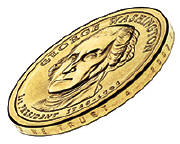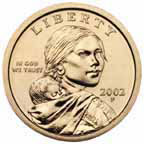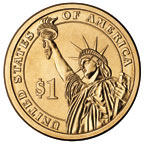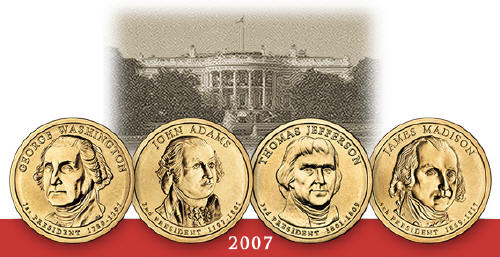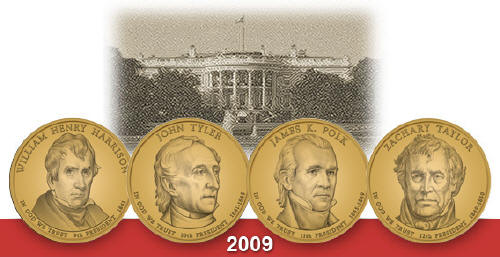|
WWW.All Certified Coins.COM |
||||||||||||||||||
|
|
||||||||||||||||||
|
Our Selection |
The Presidential $1 Coin Program The United States is honoring our Nation’s presidents by issuing $1 dollar circulating coins featuring their images in the order that they served, beginning with Presidents Washington, Adams, Jefferson and Madison in 2007. The United States Mint will mint and issue four Presidential $1 Coins per year, and each will have a reverse design featuring a striking rendition of the Statue of Liberty. These coins will feature larger, more dramatic artwork, as well as edge-incused inscriptions of the year of minting or issuance, "E Pluribus Unum," "In God We Trust" and the mint mark. Although the size, weight and metal composition of the new Presidential $1 Coin will be identical to that of the Sacagawea Golden Dollar, there are several unique features that make this coin distinctive. Edge-Incused Inscriptions The edge-incused inscriptions found on Presidential $1 Coins include the year of minting or issuance, "E Pluribus Unum," "In God We Trust" and the mint mark. However, there are two processes for producing the edge-incused lettering and each produces a different result. Due to the minting process used on the circulating and "uncirculated" quality coins, the edge-incused inscription positions will vary with each coin.T he Presidential $1 Coins are inscribed on the edge without regard to their "heads" or "tails" orientation. In addition, the location of the inscriptions around the circumference of the coin with relation to the obverse and reverse designs will vary as well. This is because the United States Mint incuses these inscriptions on the edge of each coin at the second step of a two-step coining process.In the first step,
the blanks are fed into a coining machine which
strikes the obverse and reverse designs onto the coins, and dispenses the
coins into a large bin. In the second step, the bin is transported to the
edge-incusing machine, into which the coins are fed at random, without
regard to their "heads" or "tails" orientation.
T
2007 obverse designs
George
Washington - After
the Constitution of the United States went into effect, George Washington
was elected to serve as the first President of the United States. This
former Commander-in-Chief of the Continental Army during the Revolutionary
War served two terms as President, from 1789 to 1797.
President Washington held the country's first Cabinet meeting. This
Cabinet included Alexander Hamilton, our first Secretary of the Treasury,
and Thomas Jefferson, the first Secretary of State. President Washington
himself laid the cornerstone for the United States Capitol building in
Washington, DC, on September 18, 1793.
John Adams - During the Revolution, Adams used his skills as a diplomat to represent
the United States government in France and Holland. He helped to convince
other countries to support American independence. Then he served eight
years as Vice President under George Washington before being elected
President himself in 1797.
Thomas Jefferson
- was not known for speaking in public. In fact, he was
sometimes called the "silent member" of the Continental Congress, where
he represented Virginia, his home state. But he was certainly good with
a pen. Among his other writings, Jefferson wrote the first draft of the
Declaration of Independence.
After serving as America's foreign minister to France, he was elected
the country's third President. He led the way in the purchase of
Louisiana from France in 1803, doubling the country's land area. This
purchase and the group he sent to explore the new lands are the events
that the Westward Journey Nickel Series™ celebrated 200 years afterward.
After the American Revolution, Madison played a major role in setting
the course for the new country and its government. Madison helped write
the Federalist Papers, a series of 85 essays that encouraged people to
accept the United States Constitution and make it law. He urged Congress
to pass the Bill of Rights as well. James Monroe
- Virginia native was overwhelmingly elected the 5th President of the
United States. Monroe, you see, fought in the Revolutionary War;
supported the Bill of Rights; and served as a US diplomat in Europe, as
governor of Virginia, as senator, as secretary of state, as secretary of
war, and as a negotiator of the Louisiana Purchase. His experience made
him an excellent candidate for the presidency. As president, Monroe laid the foundation for American foreign policy in
an 1823 message to Congress. This policy, which warned European powers
against expanding in the Western Hemisphere, became known as the Monroe
Doctrine. To keep the balance between free states and slave states, he helped
devise the Missouri Compromise. The Compromise also set a boundary line
across the country. Above that line (36 degrees 30 minutes north
latitude), no Louisiana territory could introduce slavery.
John Quince Adams - The sixth President of
the United States, John Quincy Adams grew up in the world of politics.
His parents were Abigail Adams and her husband John, the nation’s second
president. As a child, John Quincy often went to Europe with his father,
who served as a diplomat there during the American Revolution. Adams’s election was only by a slim margin. It was finally decided in
the House of Representatives by one vote. As president, Adams helped to
boost the economy and make it easier to trade among the states by setting
up a system of roads and canals. For example, the Cumberland Road was
extended into Ohio. Adams ran for a second term as president, but lost the election. He
then went on to serve in the House of Representatives for nine terms! He
and the 17th president, Andrew Johnson, are the only two former presidents
(so far) who later served in Congress.
Andrew Jackson - was the first president
elected from a state west of the Appalachian Mountains (Tennessee). At
the age of 13, he served a South Carolina regiment during the
Revolutionary War. Jackson later became famous as a hero of the War of
1812. His sternness as a commander earned him the nickname “Old Hickory.” As president, Jackson worked to strengthen the executive branch and
vetoed more bills than the six prior presidents combined. He was chosen
to run for a second term, but in a different way from previous
presidents. Instead of Congress holding a special meeting to pick a
candidate, Jackson’s party held a convention. Jackson was elected for a
second term. He strongly believed in the power of the federal government over
states’ rights so the country could stay united. During Jackson’s term,
Congress enacted a tariff on certain goods. When one state didn’t agree
with the tariff, Jackson took a strong stand against the state’s refusal
to pay. President Jackson authorized three new branches of the United States
Mint in 1835. The branches were opened in the Southern cities of New
Orleans (Louisiana), Charlotte (North Carolina), and Dahlonega (Georgia).
Martin Van Buren - was the first president
who was born an America citizen, the first from the state of New York, and
the first whose parents were Dutch rather than British. His interest in
politics began at his father’s tavern in Kinderhook, New York, where
politicians like Alexander Hamilton and Aaron Burr would stop as they
traveled. He served in the United States Senate and was governor of New York
before he became Andrew Jackson’s secretary of state. He served as vice
president during Jackson’s second term and was easily elected president in
1837. Rather than allowing federal funds to be held in a national bank or
even in state banks, Van Buren insisted on creating a federal treasury
system for that purpose. He also headed off disagreements with Great
Britain, keeping the country out of war. But an economic depression had
taken hold soon after he entered office and it lasted for most of his
term. He lost the election to a second term in 1841. William
Henry Harrison - led troops to victory in the Battle
of the Thames and the Battle of Tippecanoe (against American Indians),
which earned him the nickname “Old Tippecanoe.” was born in Virginia. His
father Benjamin had signed the American Declaration of Independence in
1776 when William was 3 years old. Harrison later served in Congress and as a minister to Colombia. In
1840, the Whig party asked Harrison to run against the President, Martin
Van Buren. Van Buren had become unpopular because of an ongoing economic
depression. With John Tyler as his vice-presidential running mate, Old Tippecanoe
was the first to use a campaign slogan. “Tippecanoe and Tyler Too” is
still one of the most memorable campaign slogans ever. Harrison defeated
Van Buren by a wide margin. Within one month of taking the oath of office, Harrison caught a cold,
then pneumonia. He became the first US president to die while in office.
Harrison, 68, was the oldest of the first nine presidents. John Tyler - was born in 1790 to a family of Virginia planters. Trained as a lawyer, he served as a state delegate and governor of Virginia, as a Congressman, and as vice president for one month under President William Henry Harrison. When Harrison died after just one month in office, Tyler became the first vice president to assume the presidency on the death of the elected president, as the US Constitution required. Yet the Constitution didn’t give many details about how this was to be done. This made many people wonder whether Tyler was a full-fledged president or not. Some called Tyler “His Accidency” and considered him only an acting president with limited powers. But Tyler was ready to take on all the duties and powers of an elected president, and he did so. His party became unhappy with Tyler, however, when they saw how independently he tended to act. When he vetoed a national bank bill that the Whigs favored, almost his entire cabinet resigned in protest. He was also in favor of Texas becoming a state, which was a hotly debated topic at the time. Just three days before leaving office, he signed the bill that annexed Texas. James K. Polk - America’s eleventh president, was born in 1795 in North Carolina. Despite his serving six terms in Congress (including four years as Speaker of the House) and one term as Governor of Tennessee, he was relatively unknown. This made him the first national “dark horse” candidate when the Democratic Party nominated him to run for President of the United States. He narrowly won the presidency over Henry Clay. Polk strongly believed in “manifest destiny,” the idea that the United States was clearly meant to expand across North America. During his time in office, Polk helped the country grow by more than one million square miles. Oregon and Washington were annexed from Great Britain; California and New Mexico were added through war with Mexico; and Texas’s border was expanded to the Rio Grande. Polk worked hard and rarely asked anyone to help him. He hardly even took a day of vacation while he was president. As he had pledged, he served for only one term. He died in Nashville, Tennessee, just three and a half months after leaving office. Zachary Taylor - the twelfth president, was born in 1784 in Virginia. Soon after his birth, his family moved to a plantation near Louisville, Kentucky, where he then grew up. Taylor began a long career in the Army when he was 23, soon after Lewis and Clark returned from their explorations. Over the following 30 years, he served in many frontier outposts from Louisiana to northern Wisconsin. The way he led forces to victories in the Mexican-American War earned him the nickname “Old Rough and Ready.” Taylor became a national hero and an obvious choice as a candidate for the presidency. In 1848, he won the general election in a three-candidate race, as a Whig. He had much military experience, but little as a holder of public office. The Whigs were dismayed to find him an independent thinker, not dedicated to only the party’s ideas. More to come:
More facts about the United States dollar coin: Statistics - Diameter: 26.5 mm, Weight: 8.1g, Composition: Manganese-Brass Thickness: 2 mm Edge: edge-lettering Key dates - N/A Common known errors and varieties - 2007
In closing - Like the Statehood quarter series this should be a fun series to collect. It will be more difficult or challenging as dollar coins don't circulate as much as quarters do. As with the quarters you will have several options: all Denver Mint, all Philadelphia Mint, Both P & D, or the whole set P & D, P & D SMS, and Proof.
All picture are "United States Mint Images". |
|||||||||||||||||
| Certified Cents | ||||||||||||||||||
| Certified Nickels | ||||||||||||||||||
| Certified Dimes | ||||||||||||||||||
| Certified Quarters | ||||||||||||||||||
| Certified Halves | ||||||||||||||||||
| Certified Dollars | ||||||||||||||||||
| Certified Errors | ||||||||||||||||||
| Certified Others | ||||||||||||||||||
| Silver eagles | ||||||||||||||||||
| Commemoratives | ||||||||||||||||||
|
|
||||||||||||||||||
| MORE PAGES TO | ||||||||||||||||||
| LOOK AT | ||||||||||||||||||
| US Native American Dollar Program | ||||||||||||||||||
| New Lincoln Cents | ||||||||||||||||||
| New US Presidential Dollars Series | ||||||||||||||||||
| 2004-2006 Westward Journey Nickels | ||||||||||||||||||
| Certification Companies | ||||||||||||||||||
| Free Coin Wallpaper | ||||||||||||||||||
| Accepted payments | ||||||||||||||||||
| Order Form | ||||||||||||||||||
| Contact | ||||||||||||||||||
| Home | ||||||||||||||||||
|
I hope this information helps answer some of your questions & don't forget to bookmark this page! |
||||||||||||||||||
